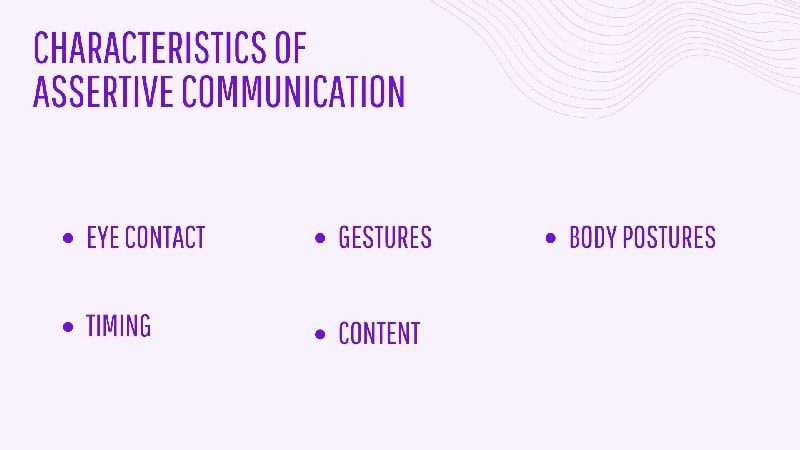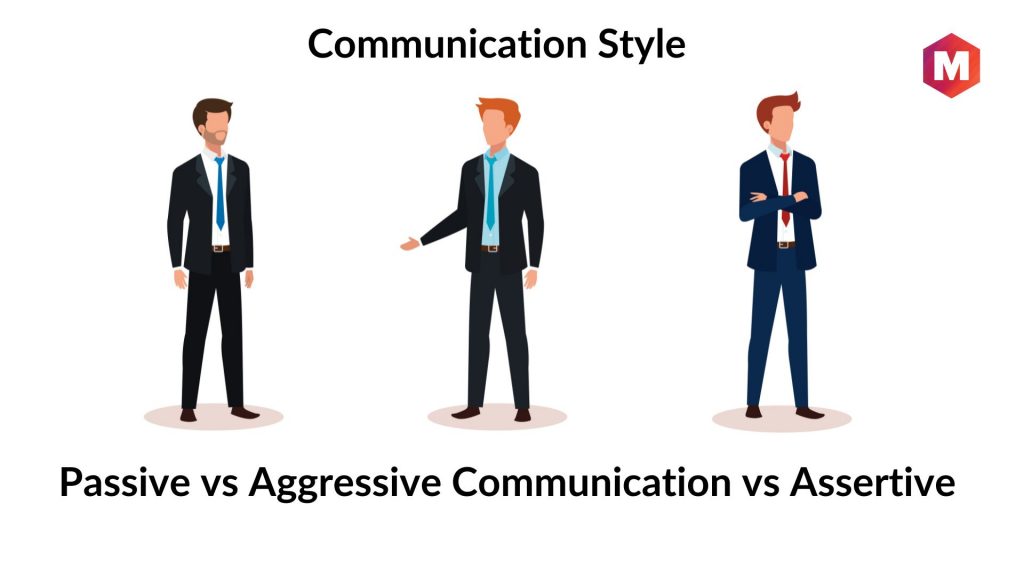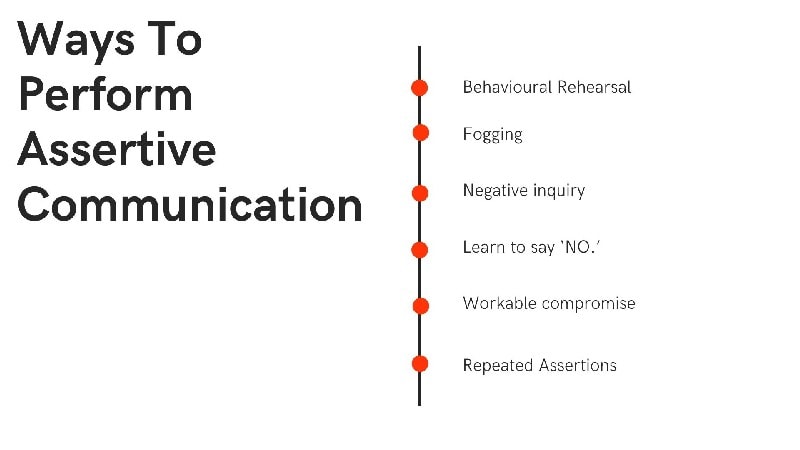
What is Assertive Communication: Understanding Its Significance and Identifying Its Types

Assertive communication is a powerful tool that allows you to express your thoughts and values while respecting others It can reduce stress, increase confidence, and foster healthy relationships With the right techniques and skills, you can master assertive communication and create a positive environment for personal and professional growth
Assertive communication allows you to express your beliefs and opinions in a respectful manner, without causing harm to others. It is a highly effective way to advocate for yourself and others without resorting to aggressive behavior. By mastering the art of assertive communication, you can minimize stress, drama, and conflicts in your personal and professional relationships.
"Assertiveness training can empower individuals to communicate more confidently and effectively, as stated by Doreen Virtue. By embracing assertiveness, one can break free from being a passive recipient of insensitive behavior and instead earn self-respect. This newfound self-respect allows for more time to focus on personal priorities and the development of genuine, healthier relationships."
Practicing assertive communication in real-life situations is not an easy task. It requires a proper understanding of this communication style and consistent practice to master it effectively. In this article, we will delve into the topic of assertive communication and provide tips on how to improve it for your benefit. Before that, let's first define what assertive communication entails.
What is Assertive Communication?
Assertive communication is a powerful tool that can create mutually beneficial outcomes. By expressing your thoughts and feelings while also showing respect for the perspectives and beliefs of others, you can achieve a balance between advocating for yourself and considering the needs of those around you.
Finding a balance between assertive behavior and non-confrontational communication styles is crucial. Aggressive communication can cause emotional harm and damage relationships, while passive communication can lead to stress, negative emotions, and resentment.
Assertive communication allows for the resolution of both issues in a confident and effective manner. Through this form of communication training, individuals can demand respect without resorting to disrespectful behavior.
Importance of Assertive Communication Style
Assertive communication style has the significance of its own. Following are some of them:
Assertive response boosts up your confidence level.
It helps you achieve your goals without hurting others.
It makes you a better stress-free person with high self-esteem.
Assertive behavior leads to clear, open and direct communication. It prevents misunderstanding between you and others.
It makes you trustworthy to others as you respect others’ feelings.
It creates a good relationship with others as you take a count on others’ beliefs.
It helps you achieve your goals in the right way.
It leads to the development of a mutually respectful relationship.
It reduces the stresses of your life and anxiety and helps you keep calm.
It does not let you hurt each other.
Different Benefits of Assertive Communication
"Why should I practice assertive communication?" is a common question that arises when first introduced to the concept. The answer is simple: practicing assertive communication will benefit you in the long run and lead to a better future.
Practicing assertive communication can result in improved communication, reduced misunderstandings, and increased assertiveness in daily interactions. It is a well-balanced approach to communicating with others that provides numerous benefits.
1) You get a Better communication
Assertive communication helps you get better communication without the risk of being misunderstood. It improves your managing skills too.
2) Less stress develops in your life
As you stay calm with your stress management problems, it helps you stay less stressed about life. You become more relaxed and composed through this.
3) You gain more trust from others
You become more trustworthy to others due to your respect for others’ beliefs.
4) You become more confident ultimately
As you learn to express your feelings and needs, you become more confident and boost your self-esteem.
5) Assertive communication creates a respectful environment where everyone grows and matures in
The practice of assertive communication results in the establishment of positive relationships and mutual respect. Assertive communication involves active contributions from everyone involved towards the enhancement of ideas, and feedback is received and acknowledged in a positive manner.
6) Assertive communication lets you feel good about ourselves and others
Self-esteem plays a vital role in assertive communication, as it reflects a high level of confidence in oneself. By expressing your opinions and standing up for your rights, you show that you value yourself and refuse to be controlled by others.
Now, in the next section, we will be covering some of the characteristics of assertive communication-
What are the Notable Characteristics of Assertive Communication
Specific characteristics make assertive communicator behavior different from the aggressive and passive communication. Let’s see what six of the essential features.
Eye contact
This leads you to talk to the opposite person directly with a clear vision and demonstrates sincerity
Gestures
Positive body language increases the listener’s interest also. It helps to communicate assertively draw the opposite person’s attention.
Body postures
A confident upright body posture helps the expression of confidence and self-esteem.
Voice
Right toning and clear voice pull in the attention of the opposite person. And it helps to express your views clearly.
Timing
A proper judgment to point out the timing helps to express the views and other person’s motives adequately.
Content
Incorporating the right content in your discussion/debate and putting that forward at the right time is quite critical in assertive communication.
In addition to these characteristics, three Cs play a significant role in assertive communication-
3 Cs of assertive communication
There are main three main points of assertive communication that defines it.
These three points collectively determine what assertive communication is.
Let’s read the following and see what these three mean more broadly.
Controlled: it is about the expression of your emotions in a calm and composed manner without getting emotional.
When communicating, it is important to be clear and avoid any confusion or misunderstanding. This means delivering your message in a way that is easy to understand and free from ambiguity. Additionally, having confidence in yourself and your ability to handle any situation can also play a key role in effective communication.
Here is a video byon Assertive Communication.
Passive vs Aggressive Communication vs Assertive Communication Style
Assertive, passive, and aggressive communication are distinct styles of communication. Passive communication, in particular, involves remaining silent and not expressing your own needs or desires, allowing others to take the lead in conversations. This behavior can result in feelings of frustration and self-disappointment, as you may feel as though you are not being authentic or standing up for your values.
Instead of using forceful and aggressive actions or words to get their way, assertive communicators prioritize respect and mutual understanding. They engage in open and honest conversations, discussing their needs and desires while also actively listening to the other person's perspective. Through compromise and collaboration, both parties are able to feel heard and respected, creating a more positive and productive outcome.
Ways to perform Assertive Communication
With dedication and perseverance, assertive communication can be mastered. By implementing the following skills and consistently practicing, you can enhance your ability to communicate assertively.
1. Behavioural Rehearsal
A person's appearance and manner of speaking play a significant role in communication. Nonverbal cues such as posture and vocal projection can grab someone's attention. Additionally, using "I" statements can help individuals express negative emotions in a constructive way and improve their assertive communication skills.
2. Fogging
This enables you to embrace constructive feedback from others, leading to personal growth. It reinforces the idea that there is always room for improvement, without triggering anxiety or defensiveness.
3. Negative inquiry
Clarify Your Thoughts and Turn Criticism into Constructive Feedback
4. Learn to say ‘NO.’
A useful technique for managing comments is to carefully evaluate each one and determine if it is informative or manipulative. Accept the comments that provide valuable insights and reject those that are simply meant to manipulate. It's important to clarify your thoughts and turn criticism into direct and clear requests for feedback in order to help yourself grow and improve.
It's important to prioritize your work and learn to decline certain requests or tasks. However, saying "NO" can be difficult and uncomfortable. A helpful way to improve your ability to decline is to practice role-playing scenarios with your colleagues.
5. Workable compromise
Assertive communication also emphasizes the importance of accepting the limitations of others. It is crucial to recognize that we cannot control everything about someone's thoughts and beliefs. Sometimes, it is more beneficial to find a compromise that aligns with our personal values and emotions.
6. Repeated Assertions
By utilizing assertive communication techniques, you can feel at ease when faced with various verbal ploys designed to manipulate you. This method is particularly helpful when confronted with irrelevant arguments or arguments intended to provoke. To employ this tactic effectively, it is important to remain calm, repeat your point, and stay focused. Consider the following example:
"I would like to share information with you regarding our services."
“No thank you, I am occupied and not interested.”
“I comprise a wide range of services to offer you.”
“That may be true, but I’m not available to listen right now.”
“Is there someone else here who would like these services?”
“I don’t know about anyone looking for these services.”
“Okay, would you mind taking this brochure and thinking about it?”
“Yes, I will take your brochure.”
“Thank you.”
“You’re welcome.”
So, this is how you can use assertive communication successfully. Let us now go through some of the critical tips of assertive communication-
How to master Assertive Communication Skills
1. Have the right tone
While having assertive communication, you must opt for the right toning skills when you put forward your opinion.
The tone of a message can have a significant impact on its effectiveness. It is essential to be mindful of the tone used, ensuring it is calm and relaxed and appropriate for the audience and situation. An irritated, exhausted, or aggressive tone should be avoided for effective assertive communication.
2. Have will to continue the discussion to find the solution
A discussion or conversation can only productive and constructive if it reaches the final solution.
To foster a productive conversation, it's important to practice assertive communication. This means maintaining a positive and respectful attitude throughout the discussion, encouraging everyone to participate. In contrast, passive communication involves walking away from the conversation, while aggressive communication relies on dominating and loud behavior.
Listening attentively, presenting multiple alternatives, and engaging in respectful dialogue are essential components of assertive communication.
3. Pay heed upon the nonverbal communication
It's important to maintain a balance between assertiveness and respect for others, and being aware of your body language can help achieve that. Nonverbal cues can either reinforce or undermine your message, so it's crucial to pay attention to them during communication.
Maintaining eye contact during a conversation is crucial for assertiveness and focus. In fact, in certain situations, nonverbal communication can even carry more weight than verbal communication.
Final Thoughts about Assertive Communication!
Incorporating assertive communication can be a difficult task, but by utilizing the strategies outlined above, mastering this skill is within reach. We hope this article has provided valuable insight and assistance in enhancing your assertive communication abilities. Thank you for reading and we look forward to welcoming you back soon.
What do you believe are the key advantages of utilizing assertive communication during discussions or debates? Have you previously had any experience with this type of effective communication? If you have any questions, please don't hesitate to ask us in the comments section.
Share with us and make this post the best place to master assertive communication skills.
NEXT
Asynchronous Communication
PREV
Grapevine Communication
START
Types of Communication



















